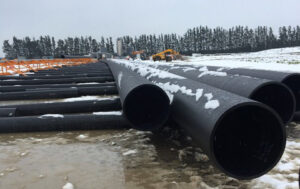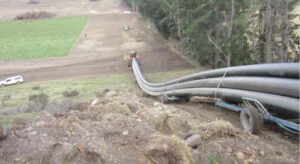Pipes are a vital element of water infrastructure, and many projects require miles of pipe to complete. The transportation and fusion of large pipe segments is often both expensive and time consuming, and multisection pipes also have more possible failure points. Tubi Group set about to make the fabrication, transportation, and installation of pipes better by creating onsite plants that fabricate pipe at the site where it is needed. In this interview, Wes Long, Tubi Group’s chief operating officer, tells Irrigation Leader how the onsite plants work and their advantages over traditional offsite construction facilities.
Irrigation Leader: Please tell us about the history of Tubi.
Wes Long: Marcello Russo began the business in 2009. His father owned a large plastic pipe manufacturing factory in Australia that made PVC pipe, polyethylene pipe, and other types of plastic pipe. When the family elected to sell the business, Marcello obtained a share of it, and instead of rebuilding or opening another factory, he thought there might be a better way to make manufactured high-density polyethylene (HDPE) pipe. He came up with the idea of what we call mobile or onsite extrusion manufacturing.
He designed special modules to house extruders, vacuum tanks, cooling tanks, and all their downstream equipment, creating mobile extrusion plants. These are turnkey plants that use Battenfeld technology, the finest extrusion technology in the world. Our plants have the highest throughput or output rates in pounds per hour of any equipment today.

We don’t sacrifice anything by doing mobile extrusion. In fact, we have better technology than nearly all the brick-and-mortar HDPE pipe manufacturers, a lot of which are still using older equipment and technology that doesn’t run at the highest rates or output or use the in-line quality control that Tubi runs today.
We have two brand-new plants, one in Florida and one in Odessa, Texas, plus an original plant in Odessa, Texas. The two new plants have the latest technology, the newest extrusion capability, and the newest quality-control systems. Our new plant in Florida is located at a base site with main electric power in Bartow, Florida, which is a mobile extrusion site but also a permanent location from which we can serve Florida and the entire southeastern United States with truckload deliveries of pipe just like any other pipe manufacturer. We are planning to build an additional base site in Arizona to serve the vast mining business there.
We have a maintenance, repairs, and operations supply agreement with Mosaic, the largest fertilizer manufacturer in the world. It produces phosphate and turns it into fertilizer. When we received the Mosaic contract, the first project was to manufacture about 7 million pounds of polyethylene pipe of sizes from 12 to 24 inches. We were able to produce all of that in 500‑foot lengths right at the job site. Traditionally, pipe is manufactured at lengths of 40 or 50 feet, so our pipe is much longer. We are also looking to recycle old HDPE pipe used on Mosaic’s sites to produce new HDPE pipe for Mosaic.
Our next step is producing larger-diameter pipe, up to 48 inches and beyond. The 48-inch plant is designed and ready to go, but we are looking for an appropriate project. Large pipe gives us a greater value in freight savings and savings on joining costs. Larger-diameter pipe requires many more trucks for transport, has higher handling costs, and takes longer to join. Manufacturing at a job site eliminates 90 percent of the fusion welds, which saves an enormous amount of time and money. It also allows us to eliminate all truck traffic and freight.
Irrigation Leader: How does the base site differ from your mobile plants?
Wes Long: We have a nonmobile base site in Bartow, Florida, where we have a huge demand for pipe, with Mosaic as an anchor account. Mosaic is the largest user of HDPE pipe in the state of Florida and is a core contract customer. We originally moved to Bartow for a large mobile extrusion project with Mosaic, but we ended up taking out a long-term lease on the base site from Mosaic because of the high demand for HDPE pipe in Florida and the absence of other pipe manufacturers in the area. In addition to our work with Mosaic, we have a great relationship with a company called Ferguson Waterworks, the market industry leader in the United States for the distribution of water and wastewater pressure HDPE pipe for potable water, sewers, force mains, and so on. Most of what we don’t sell to Mosaic goes to Ferguson Waterworks or to other distributors in Florida.
Irrigation Leader: What year did Tubi start operating in the United States?
Wes Long: Marcello began operations in West Texas with the oil and gas market in early 2018. Oil prices plummeted in early 2019, bringing all that business to a halt. We were fortunate enough to subsequently move two plants, while most brick-and-mortar factories lay idle. We moved our assets to Florida and won a huge bid with Mosaic, which stayed in operation during COVID‑19 as an essential business. We were deemed essential, too, because we were making the pipes Mosaic needed to make fertilizer for farmers who provide food throughout the world.
Irrigation Leader: Approximately how many modules are in one of your mobile plants?
Wes Long: It takes 20 flatbed trucks to move a plant. We bring in a crane and load our containers onto trucks. There are about 8–10 modules, plus other equipment. Two of them are double stacked, because the extruder and the hopper above it are taller than an individual container. There are multiple stacks of containers as well. The silos in which we hold our raw material resin feedstock are mobile and have wheels at the base. They can be lowered to the ground by heavy equipment, hooked up to a tractor trailer, and pulled on the highway.
Irrigation Leader: How long does it take to dismantle and reconstruct one of your plants?
Wes Long: In New Zealand, we generally moved our plants 30–50 kilometers (18.6–31 miles) and could go from in-spec pipe to in-spec pipe within 56 hours. For a distance greater than that, it would be 56 hours plus travel time.
Irrigation Leader: How do you transport the 500-foot lengths of pipe you produce, and how far can they be transported?
Wes Long: We recommend our dolly system technology for moving large volumes of long-length pipe. It is a set of trailers with heavy-duty axles that are chained together and can be pulled with a trailer or a piece of heavy equipment. The smaller the size, the greater the quantity of 500‑foot lengths it can fit. We have a design spreadsheet that shows how many lengths of each size pipe we can pull safely based on the weight capacity of the trailers. This system means the pipe does not have to be dragged and potentially damaged.
When we presented our dolly systems to the mines we’ve been dealing with in Florida and talking to in Arizona, they were really excited, because they know the problems caused by dragging pipe. When pipe is dragged, it suffers gouges that often exceed 10 percent of their wall thickness, taking away from the life of the pipe.
Irrigation Leader: How far would you move the pipe before considering moving the plant closer to the project?

Wes Long: We can traverse some pretty difficult terrain in pretty severe conditions with all-terrain-vehicle tires and a big tractor, but the dolly system would not be street legal on a major highway unless the police were blocking traffic. If we had a right of way in a rural environment like the ones we worked in New Zealand, we could use it to move pipe up to 50 miles. We could set the plant up in a central location and transport the pipe in both directs to minimize how far we had to go. It would always be cheaper to move the pipe, as long as there is a path and an access point for our trailers.
We had to move our mobile plant two or three times in New Zealand. Those moves were anywhere from 30 to 50 kilometers (18.6–31 miles) in length. There wasn’t a good way to get the pipe from point A to point B, or we would not have moved the plant. The short distance wasn’t too difficult, and we were able to do the move quickly. We didn’t have main power, so we used diesel-powered generators to run that plant. In Florida, Mosaic has its own power generation system, so we’ve been able to hook up to the main power there.
Irrigation Leader: Once you start the extruding process, does it continue 24/7?
Wes Long: Yes. If we didn’t have to stop, we wouldn’t stop. Usually, we stop to change sizes or change a die or the calibration sleeves to make a different outer diameter.
Irrigation Leader: What materials do you need to bring into the site, and how do you transport them?
Wes Long: We use resin pellets to make the HDPE pipe, and in sites without a power or water supply, we bring in diesel fuel for the generators as well as water.
We like to transport everything by rail, just like a brick-and-mortar factory. Most of the plants have a rail spur at the location or in close proximity. In Florida, our rail spur is about 5–10 miles from our site. We bring in 200,000‑pound rail cars of resin and store the resin on a rail siding. We use hopper bulk trucks to vacuum-convey the resin into trucks and then bring it to our plant and unload it into our silos.
We need about 4,000 gallons of water to start up and then just add water to make up for evaporation and to use in the cooling of the product. Otherwise, it’s recirculated and filtered.
Generally, we need a continuous feed of resin, a continuous feed of fuel, and makeup water, but in Florida, we have electricity and are hooked up to a water supply, so all we need is the resin.
We need wood for packaging if we need to package and ship the pipe, but if we’re making it on site, no packaging material is needed
Irrigation Leader: What should irrigation districts in the 17 western states know about your company?
Wes Long: A lot of rural irrigation districts need to replace ditches with more efficient pipelines. Heat-fused polyethylene pipe is highly efficient. We’re making pipe with outer diameters from 4 to 26 inches. Soon, we will upgrade one of our plants to do 12-inch and 48‑inch pipe. Our extruders are big enough to do this bigger pipe, but we need bigger downstream equipment: bigger vacuum tanks, cooling tanks, saws, and pullers. We have a design for modules that will contain that downstream equipment. That will be attractive to irrigation companies that use larger-diameter pipe. We’ll be able to save them a tremendous amount of money and provide them a higher-quality system by eliminating 90 percent of fusion welds.
In some of those big jobs, the bigger the pipe, the higher the freight cost. There is typically a 45,000‑pound weight limit for a truck on a highway, and with 48‑inch pipe, you can max out the weight limit at four joints on a truck. With 54-inch pipe, you can only put two joints on a truck. If you’ve got miles of pipe, you are looking at hundreds, if not thousands, of truckloads of freight shipping from a brick-and-mortar factory to a job site. That entails lots of handling, unloading pipe from trucks, moving it to yards, staging it, and moving it again to where it needs to be installed. We eliminate safety risks by making the pipe on site and eliminating all the freight and handling of heavy polyethylene pipe. We provide a higher-quality product because our pipeline has many fewer joints, which are the most common spots for leaks.
We have tremendous quality-control equipment that most of our competitors do not have. We use a European company called Sikora that has developed radio-wave and X-ray technology. The radio-wave technology allows for continuous monitoring during production, close to the front of the extruder, right behind the first tank. We put a machine in there that continuously rotates 360 degrees around the pipe as it is being produced. It measures every dimension of the pipe during production, giving us the minimum and maximum outer diameter, the wall thickness, the inner diameter, the ovality, and the eccentricity. Eccentricity is the variability of the wall around the pipe—the difference between the minimum and the maximum wall in a given cross section of pipe. We try to limit that in order to make pipe in spec as quickly as possible.

We also have the latest die technology, which allows us to make changes in pipe size that were once unheard of. Before, if we wanted to change from a 6-inch pipe to an 8-, 10-, or 12-inch, we’d have to change the die in all the tooling every time. The new quick-change die technology allows us to change into multiple outer-diameter sizes off one die set. It makes for quicker changeovers and minimizes scrap.
Wes Long is the chief operating officer for Tubi Group. He can be reached at wes.long@tubigroup.com or (214) 490‑4980.

